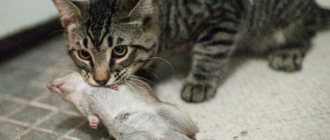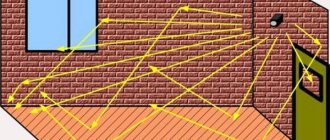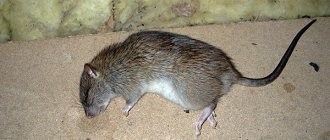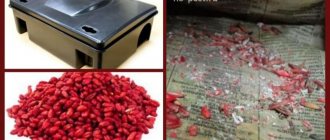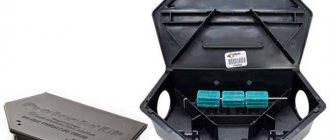Most summer residents and villagers keep chickens to feed their households not only tasty, but also fresh, harmless products. Eggs are used to fry omelettes, make filling for pies, and poultry meat is used for first and second courses. But sometimes rats are able to enter an outbuilding. Rodents bring many problems to owners, so it is necessary to immediately take measures to expel them. How to get rid of rats in a chicken coop, what methods to protect the building from invasion?
The chicken coop is a real paradise for aggressive pests. The building is always dry, and even in severe winter cold it is warm. There is a lot of food here, ranging from full feeders to stocks of grain or animal feed. In addition, rats will never miss an opportunity to profit from chicken eggs. That is why they are able to attack chicken coops with amazing tenacity and inhabit them with lightning speed.
How to get rid
There are several ways to protect chickens from rats. The most common of them are setting traps and using chemicals. Poisons and traps often pose a threat to the birds themselves: they can be harmed by a trap or eat poisoned food.
For this reason, people are increasingly resorting to modern methods of solving the problem: installing ultrasonic repellers, breeding certain breeds of dogs and cats . Let's take a closer look at how to get rid of rats in a chicken coop.
Folk remedies
Since ancient times, people have been faced with the problem of rodents settling in their households. There are many ways to control rats in a chicken coop.
Wood ash
The product is used as a rat repeller. Ash is sprinkled throughout the entire perimeter of the chicken coop and the cracks in its walls. Rats enter the poultry house at night, not paying attention to the scattered ash.
The substance causes severe itching and irritation to the skin of rodents. When cleaning the fur, some of the ash enters the rat’s digestive system, thereby provoking its poisoning and death.
Individuals that survive after consuming ash look for a new habitat. Ash does not harm chickens even if accidentally ingested.
The substance also helps cleanse birds' fur from harmful insects.
Lime and gypsum
To destroy uninvited guests, a mixture of gypsum, lime, boiled eggs and sugar is used. Poison prepared in this way is placed further away from the birds.
After consuming the sweet mixture, the rodents die immediately. Lime and gypsum, in contact with gastric juice, release a large amount of heat. The rodent dies instantly from multiple burns to internal organs.
Glass and crushed stone
If there are glass items in the house for recycling, then you can use them to make a repeller for uninvited guests in the household. It is necessary to mix crushed stone and glass in equal proportions.
Pieces of glass hidden under rubble will fall into the paws of animals, injuring their skin. Individuals, taught by bitter experience, will no longer climb into the chicken coop. Similar materials can also be added to the mixture to seal holes.
Rat poison
It is recommended to poison rodents in the household using quick-acting chemicals. The drug Krysin (in ampoules) is effective against rats.
Even small dosages of the drug are fatal to pests. You can get rid of the problem with the help of a toxic substance in 1-2 weeks. It is advisable to disguise the Rat under a piece of lard or fish.
It is important that the product is slightly spoiled: this way cunning rats will not recognize the smell of poison. Another way to use poisons is to add them to odorous drinks, such as beer.
Other poisons intended for pest control in the household include:
- Goliath;
- Ratid-1;
- Bromed;
- Brodifan.
How to protect birds and animals when using poison
Rodent poison is dangerous for birds and other animals living in the household. To prevent their poisoning, it is necessary to place baits with poison under heavy wooden boxes, where only rodents can get into.
Rats can carry the remains of poisoned food around the chicken coop, causing mass poisoning of birds. For this reason, when using poisons, it is advisable to move pets to another room for several days.
Signs of pests
You can minimize the consequences and damage caused by the gray “guest” if you monitor the condition of the farm, animals, and birds. The first signs of the appearance of the pest will be restlessness of the hens and a decrease in egg laying. Next, you can observe the carcasses of strangled chicks and a specific smell in the chicken coop. Having noticed this, inspection of the premises and their disinfection should be carried out regularly. The farmer’s main task becomes to protect and rid the farm’s inhabitants from the gray “plague.”
Litter
A rat, even one individual, always leaves litter. The feces are oblong and dark brown in color. Can be confused with mice. But they are larger. The droppings are left mainly in corners or near food.
Interesting fact! A mouse and a rat cannot live under the same roof. If you notice that suddenly all the mice in the area have disappeared, this is the first sign of a rat infestation. It is worth notifying your neighbors about a possible threat, and jointly choosing a way to calculate its location and destroy it.
New holes
The rat makes new moves for escape and escape. It is important for the animal to have several such “doors” so that it can escape when meeting a person. The sounds that the rodent makes are quite loud and can be heard even in the chicken coop. Almost every day the rat adds a new hole in the floor, walls and doors of the poultry house.
Strangled Juvenile
During the first few weeks, the rat settles in and prepares an escape route. Then he starts stealing eggs, i.e. something that is less noticeable. But the longer she runs the chicken coop, the more she allows herself. If a strangled chicken is found on the floor, it’s time to sound the alarm, set traps and bait to catch the pest.
Damaged wires
Not necessarily, but in 80% of cases, problems with electricity may arise in household plots and agricultural buildings. Any damage to the wire means the presence of a rat.
Specific smell
Sudden change in odor in the room. It is more sugary, with a bright ammonia hue. Enhances amber in corners and less ventilated areas.
Repellent methods
All methods of controlling rodents can be divided into 2 groups: destruction or repelling. Repellent devices have a negative effect on the animal’s nervous system, as a result of which it soon leaves its habitat.
Scaring can be carried out using the auditory, tactile, and olfactory receptors of rats.
Mechanical traps
The most ancient way to combat the problem is to use homemade traps. This method is not considered optimal for use in a chicken coop: rodents, when trapped, decompose and violate the sanitary conditions of the poultry house.
The mechanical method of eliminating rodents is also dangerous because chickens may suffer as a result of such actions.
Therefore, the use of traps inside poultry houses is strictly limited.
Let's consider safe options for catching rats in poultry houses:
- Using a 3 liter jar with pre-lubricating the walls of the container with vegetable oil. The animal will not be able to get out because its paws will slip.
- Using a flower pot with a pre-installed wooden guard. The container is fixed upside down on a “guard”, which falls when the rat bites off a piece of bait. It is advisable to place a sheet of iron under the pot so that the animal cannot chew its way out of the trap.
Biological
The classic way to control rodents is to have cats. Rats are afraid not only of cats, but also of dogs: dachshunds, bull terriers, fox terriers. The listed breeds are capable of injuring rodents due to their hunting instincts.
To eliminate pests, it is better to get Sphynx or Siberian cats. The fact is that not all felines can cope with a rat infestation in a chicken coop. Many pets are afraid of rodents and do not attack them.
Important information! You cannot use a biological method of exterminating rodents together with a chemical one to prevent poisoning of hunting animals.
Chemical
Large poultry farms use chemicals and aeration techniques to kill pests. In the latter case, rodents are poisoned by spraying toxic substances into the air.
When using poisons yourself, you need to remember some safety rules: lay out the bait using rubber gloves; After the procedure, wash your hands thoroughly with soap.
To achieve a greater effect, it is necessary to alternate the drugs each time, since rodents develop resistance to certain types of poisons over time.
Ultrasonic
A modern method of removing rodents from a poultry house is the use of ultrasonic repellers. The method is considered the most humane, since during it not a single living creature is exposed to harmful effects.
Ultrasonic devices generate waves that are not perceived by the human or bird ear. In rats, the device provokes a feeling of anxiety, as a result of which the pests leave the room within 24 hours.
The most popular models of rat repellers:
- Typhoon and Typhoon 800;
- Grand A-500.
The difference between the devices lies in the power of impact and the radius of the area covered. Modern devices are equipped with sensors that automatically turn the device on and off.
The main advantage of ultrasonic repellers is the constant change in the frequency of the generated sound waves.
Because of this, rodents do not have time to adapt to new living conditions.
Precautionary measures
When dealing with rats using chemicals, do not forget to take the following precautions:
- Wear protective gloves when preparing and handling the product.
- Do not use near other foods, children, or pets.
- Wash your hands thoroughly with soap after completing procedures.
- Remove poisoned corpses in a timely manner.
Use chemicals with a mummification effect to avoid breathing in the smell of decomposition, as the rat may die in a hard-to-reach place.
How eggs are stolen
Rats pose a danger to chickens and other inhabitants of nurseries due to the spread of infection and parasites. They reduce the offspring of birds by destroying young chickens and eating eggs.
Let's take a closer look at how rats steal eggs. The animals take the egg with their front paws, moving on their two hind limbs.
With its prey, the rodent is able to move not only along the floor, but also along the walls and ceiling. Most often, pests steal birds' eggs in groups, rather than individually.
Under what conditions do rats appear?
Keeping birds in a chicken coop requires special conditions in which rats also feel comfortable. A warm and dry room is an ideal refuge for these animals, especially during winter.
Keeping birds in a chicken coop requires special conditions in which rats also feel comfortable.
It will be especially easy for rats to settle in a chicken coop if a temporary home is built for the chickens, and not a solid structure with a solid foundation and floors filled with a dense layer of concrete.
If the design of the chicken coop presupposes the presence of space between the floor and the ground, then for rats or mice this is a real expanse. They easily penetrate there and move freely there, live and reproduce.
The likelihood of rats increasing as autumn approaches. In the summer it is easier for them to find food in the forest and fields, but with the onset of cold weather they have to look for new sources of food, and they attack farms.
How to get into the chicken coop
Rodents enter chicken coops through cracks in the building, open manholes, and clay floors. Rats can also enter a poultry house standing on stilts: the animals are good at climbing walls and vertical planes.
Rodents are especially attracted to the smell of eggs and warmth.
Let's consider other reasons for the appearance of rats in the chicken coop:
- sufficient feed and grains;
- suitable microclimate.
In winter, rodents escape the cold in heated chicken coops. Especially often, unwanted guests appear in those rooms where there is no foundation, but there are clay floors.
Signs of appearance
The following signs will help you recognize the presence of rodents:
- paw prints left on the floor of the chicken coop (usually rats move along the same paths);
- presence of rat feces;
- teeth marks left on wooden objects;
- the smell of ammonia in the poultry house;
- broken eggshells on the floor;
- passages gnawed into the walls and floor.
It's easier to prevent than to fight
In order not to encounter uninvited guests in the barn, it is necessary to take all measures that can protect the building from intrusion. Moreover, such measures can be carried out both at the stage of building a chicken coop and during its operation (for example, after removing rats). You can effectively protect your shed from rodent attacks using the following methods.
- Crushed stone with glass. If you are just building a chicken coop, be sure to plan for a strong and durable structure that does not lack a foundation. Do not forget that through the clay floor and walls it is much easier for rodents to get into the barn. But concrete is too tough for them. When forming the foundation, consider one more trick. When pouring crushed stone on the floor, be sure to add broken glass to it. Not a single rodent can get through such protection.
- Metal grid. This method will work if the chicken coop was built a long time ago and has an earthen floor. You will have to remove a layer of soil (approximately 40-50 cm). This hole, dug around the entire perimeter of the shed, should not go below the foundation, otherwise the side protection will be lost. Add a layer of expanded clay. Lay out a chain-link type metal mesh on it with cells no larger than 50-50 mm. Cover the structure with soil.
- Metal "stripes". If the chicken coop is made of wood, take care of external protection. Cover the walls with metal sheets. By making such protection, you can even go a little deeper into the ground.
- Brick wall. This is another method to keep rats from invading your shed. Pre-caulk all holes and cracks. Now line the outside of the chicken coop with brick. Even half-brick masonry can prevent a rat attack.
Prevention measures
The basis of prevention is the competent organization of the household and maintaining cleanliness in it. Owners are advised to promptly remove chicken droppings, collect eggs and put away feed at night.
When building a chicken coop, you need to add broken glass to the cement. Rats can chew through almost any material, but the taste of broken glass will keep them away forever. In an old building, it is important to seal all cracks and open gaps through which pests can enter.
Emergency measures must be taken immediately after rats are discovered in the chicken coop, otherwise they will cause damage to the farm and cause the spread of infection among the birds.
To eliminate the problem, homemade traps and ultrasonic repellers, chemicals and traditional medicine recipes are used. Of no small importance is the breeding of cats and dogs, which reduce the number of uninvited guests in the chicken coop.
